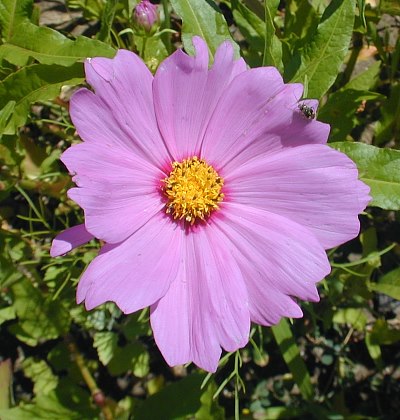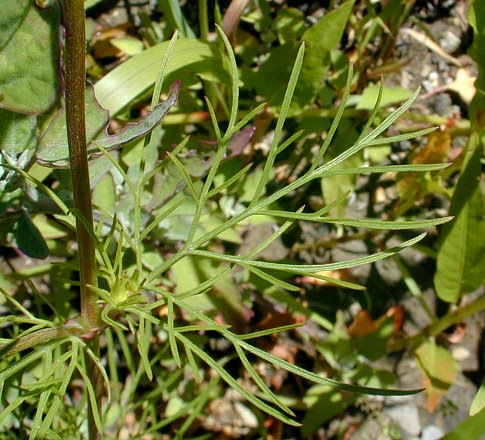
The upper stems terminate in individual flowerheads about 2-3" across that are on long naked peduncles (4-8" long). The peduncles have characteristics that are similar to the stems. Each flowerhead consists of about 8 ray florets that surround numerous tiny disk florets. The ray florets are sterile, while the disk florets are perfect and fertile. The petaloid extensions of the ray florets are white, pink, or magenta; sometimes they are bicolored. In addition, these petaloid extensions are obovate in shape and their outer edges are shallowly cleft. The circular perimeter of the disk florets spans about ½" across; it is relatively small in relation to the diameter of the flowerhead. Individual disk florets are about ¼" long, bright yellow, and narrowly cylindrical. At the base of the flowerhead, there are floral bracts (phyllaries) in 2 series; there are about 8 floral bracts
Cultivation: The preference is full sun, mesic or dry-mesic conditions, and a mildly acidic to alkaline soil containing loam, clay loam, gravel, or sand. Once the seeds germinate, growth and development is rapid. Wild plants tend to be shorter and bloom less abundantly than garden plants in fertile soil, otherwise they appear much the same.
Range & Habitat: The introduced Common Cosmos rarely naturalizes in Illinois, where it has been reported in only a few counties. Wild populations of this plant rarely persist. Common Cosmos was introduced into the United States as an ornamental flowering plant from Mexico or tropical America, and it is still commonly cultivated. Habitats include fallow or abandoned fields, roadsides, areas along railroads, and waste areas. Habitats with a history of disturbance and relatively open ground are preferred.
Faunal Associations: Very little is known about the floral-faunal relationships for this introduced plant in North America. Butterflies and possibly other insects visit the flowers for nectar and/or pollen. Insects that feed destructively on Cosmos spp. include Macrosteles fascifrons (Aster Leafhopper) and the polyphagous caterpillars of Rachiplusia ou (Gray Looper Moth).
Photographic Location: A fallow field near Champaign, Illinois.

Comments: Because of its attractive flowers, fine fern-like foliage, and ease of cultivation, it is easy to understand why Common Cosmos remains a popular garden plant. There are many cultivars to choose from. While Common Cosmos occasionally reseeds itself, it has not been invasive in Illinois. It is easy to identify in the wild because nothing else closely resembles it, except other non-native Cosmos spp., that so far have not escaped from cultivation within the state. Some Coreopsis spp. have finely divided foliage and similar flowerheads, but they tend to be shorter plants and their flowerheads are usually yellow.